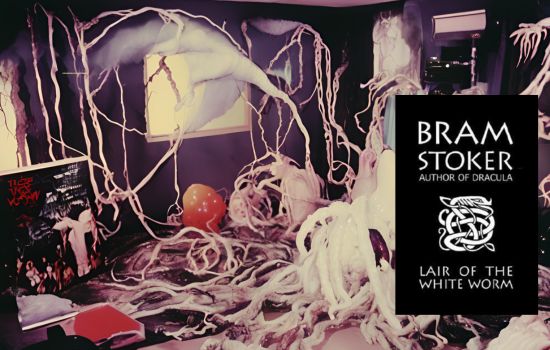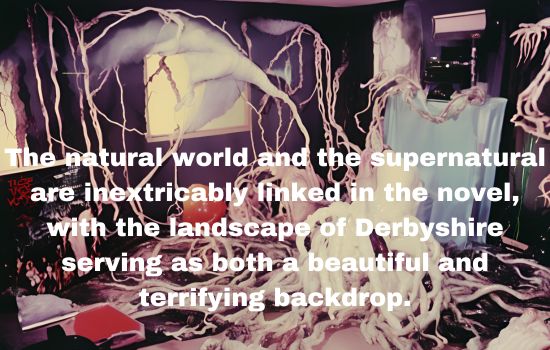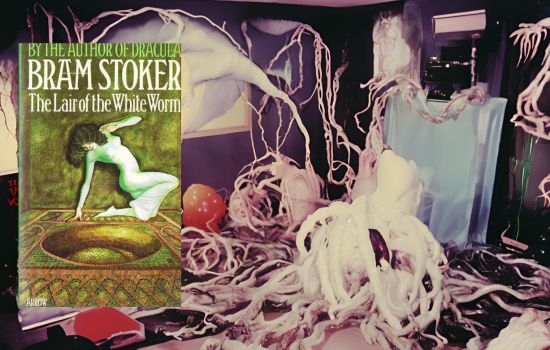
The Lair of the White Worm: A Classic Horror Tale
Bram Stoker’s “The Lair of the White Worm,” published in 1911, is a classic horror novel that intertwines elements of Gothic fiction with supernatural and scientific themes. Set in the English countryside, it explores the legend of a monstrous white worm and the sinister machinations of its human counterpart, Lady Arabella March.
Importance of Bram Stoker’s Work

Stoker, best known for “Dracula,” cemented his legacy in the horror genre with “The Lair of the White Worm.” Though it never achieved the same level of fame as “Dracula,” it remains a significant work due to its complex themes and its place in the evolution of Gothic literature.
Context of Publication
“The Lair of the White Worm” was one of Stoker’s final novels, published just a year before his death. It reflects the anxieties and scientific curiosities of the early 20th century, a time of great change and uncertainty.
Historical Context
Bram Stoker’s Literary Career
Bram Stoker’s literary journey is marked by his deep engagement with the supernatural and the macabre. “The Lair of the White Worm” continues his exploration of fear and the unknown, showcasing his mastery in crafting suspenseful narratives.
Gothic Literature in the Early 20th Century
The early 20th century saw Gothic literature grappling with new themes influenced by scientific discoveries and changing societal norms. Stoker’s work is emblematic of this transition, blending traditional Gothic elements with contemporary issues.
Influence of Victorian Society on Stoker’s Work
Stoker’s narratives often reflect the Lair of the White Worm codes and underlying anxieties of Victorian society. “The Lair of the White Worm” addresses fears related to sexuality, colonialism, and the encroaching unknown, themes prevalent in Victorian thought.
Plot Summary of The Lair of the White Worm
Introduction to Main Characters
- Adam Salton: A young Australian who becomes embroiled in the mystery of the White Worm upon visiting his great-uncle in England.
- Sir Nathaniel de Salis: A wise and knowledgeable gentleman who aids Adam in uncovering the truth behind the legend.
- Lady Arabella March: The enigmatic and malevolent owner of Diana’s Grove, suspected of being linked to The Lair of the White Worm.
- Edgar Caswall: A wealthy landowner obsessed with Mesmerism and the enigmatic Lady Arabella.
Setting the Scene: Derbyshire
The story unfolds in the picturesque yet ominous setting of Derbyshire, where ancient legends and modern fears collide.
Discovery of the White Worm Legend
Adam’s arrival in England triggers a series of events that lead to the rediscovery of the ancient legend of The Lair of the White Worm, a monstrous creature believed to inhabit the land around Diana’s Grove.
Adam Salton’s Investigation
Adam, with the help of Sir Nathaniel, delves into the history and mystery surrounding Diana’s Grove and its sinister mistress, Lady Arabella.
The Mesmerism Subplot
Parallel to the main plot is Edgar Caswall’s obsession with Mesmerism and his attempts to control the minds of those around him, adding a layer of psychological horror to the tale.
Climactic Confrontation with the White Worm
The novel builds to a tense climax as Adam and Sir Nathaniel confront the terrifying truth about Lady Arabella and The Lair of the White Worm, culminating in a dramatic showdown.
Resolution and Conclusion
The novel concludes with the defeat of The Lair of the White Worm, restoring peace to the countryside, though the lingering sense of dread suggests that not all evil has been vanquished.
Themes and Motifs
Good vs. Evil
The novel starkly delineates the battle between good, represented by Adam and Sir Nathaniel, and evil, embodied by Lady Arabella and the White Worm.
Science vs. Superstition
Stoker juxtaposes scientific inquiry and ancient superstition, exploring the tensions between modernity and the mystical.
Colonialism and Race
Themes of colonialism and racial superiority are subtly woven into the narrative, reflecting the imperialist attitudes of Stoker’s time.
Gender Roles and Power Dynamics
Lady Arabella’s character challenges traditional gender roles, presenting a powerful, albeit malevolent, female figure.
Nature and the Supernatural
The natural world and the supernatural are inextricably linked in the novel, with the landscape of Derbyshire serving as both a beautiful and terrifying backdrop.

Characters Analysis
Adam Salton
- Background and Personality: A courageous and inquisitive young man, Adam embodies the rational hero of the story.
- Role in the Story: His investigation drives the plot forward, leading to the ultimate confrontation with the White Worm.
Sir Nathaniel de Salis
- Wisdom and Mentorship: Sir Nathaniel provides guidance and knowledge, serving as a mentor to Adam.
- Contribution to the Plot: His expertise in local legends and history is crucial in unraveling the mystery.
Lady Arabella March
- Villainous Traits: Lady Arabella is a complex antagonist, whose malevolence and connection to the White Worm make her a formidable foe.
- Symbolism and Significance: She symbolizes the corrupting influence of power and the perils of unchecked ambition.
Edgar Caswall
- Madness and Obsession: Caswall’s descent into madness and his obsession with Mesmerism highlight the dangers of unchecked scientific curiosity.
- Interactions with Other Characters: His interactions with Lady Arabella and other characters add depth to the psychological tension of the story.
Symbolism
The White Worm as a Symbol
The White Worm represents ancient evil and the persistence of malevolent forces across time.
Mesmerism and Mind Control
Mesmerism serves as a metaphor for the manipulation of power and the fragility of the human mind.
Snakes and Serpents in Literature
Snakes and serpents have long been symbols of danger and deceit, and Stoker uses these motifs to enhance the novel’s atmosphere of dread.
Gothic Elements
Traditional Gothic elements such as decaying estates, hidden passages, and dark secrets pervade the novel, creating a sense of foreboding and suspense.
Literary Devices

Use of Suspense and Horror
Stoker masterfully builds suspense through meticulous pacing and atmospheric description, creating a palpable sense of horror.
Descriptive Language and Imagery
Rich, evocative descriptions bring the settings and characters to life, immersing readers in the eerie world of the novel.
Symbolism and Allegory
The novel’s symbolism adds layers of meaning, inviting readers to explore deeper themes and societal critiques.
Dialogue and Character Development
Through dialogue, Stoker develops his characters’ personalities and motivations, making their interactions and conflicts more compelling.
Reception and Criticism
Contemporary Reviews
Upon its release, “The Lair of the White Worm” received mixed reviews, with some praising its imagination and others criticizing its convoluted plot.
Modern Interpretations
Today, the novel is often viewed through a critical lens, examining its themes and Stoker’s use of horror to comment on societal issues.
Critical Analysis
Scholars have analyzed the novel’s exploration of fear, power, and the unknown, highlighting its significance in Stoker’s oeuvre.
Comparisons to Stoker’s Other Works
While not as celebrated as “Dracula,” “The Lair of the White Worm” shares many thematic and stylistic similarities with Stoker’s other works, showcasing his enduring preoccupations.
Adaptations
Film Adaptations
The most notable adaptation is Ken Russell’s 1988 film, which takes significant liberties with the source material, blending horror and dark comedy. Read another horror book Cujo by Stephen King: A Gripping Tale of Horror and Survival.
Stage Adaptations
Though less common, stage adaptations have explored the novel’s dramatic potential, emphasizing its Gothic elements.
Influence on Other Media
The novel has inspired various media, including radio plays and graphic novels, demonstrating its lasting impact.
Conclusion
“The Lair of the White Worm” is a multifaceted horror novel that delves into themes of evil, power, and the supernatural. Through rich symbolism and evocative descriptions, Stoker creates a compelling narrative that continues to captivate readers.
Despite its initial mixed reception, the novel has gained recognition for its complexity and its place in the canon of Gothic literature. It remains a fascinating exploration of early 20th-century fears and anxieties.
For those intrigued by “The Lair of the White Worm,” delving into Stoker’s other works and the broader context of Gothic literature offers a deeper understanding of this enduring genre.